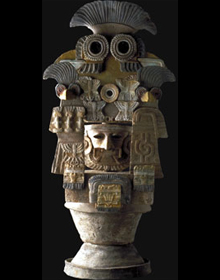resources
Museum Collections - Mesoamerica - Teotihuacan - Artifact #4

WHO: Teotihuacan culture
WHERE: Northeastern Valley of Mexico
WHEN: Classic Period, A.D. 250- 650
WHAT: Lidded censer (incense burner). Censers were not only placed whole in graves as funerary offerings, but were also broken and scattered around the body of the deceased. It was common to set such censers within courtyards shared by adjoining households, and to use them for burning incense on communal staircases.
Butterfly imagery is believed to be a symbol of fertility. It is prominent on censers, and in addition many butterfly-shaped plates have been found at Teotihuacan. The censer pictured left is adorned with four moulded butterflies above the recessed face in addition to a fifth butterfly to the left of the human face on the censer.
Height: 66.3cm
HOW: Brown earthenware decorated with polychrome pigments and Mica insets. Hand-modelled base adorned with mould-made ceramic plates.
MUSEUM: Gardiner Museum of Ceramic Art. G83.1.18
Zoomify Interactive: To see an image of this artifact that you can zoom in on, click on this link: Front (Warning: This link will open in a new window)

